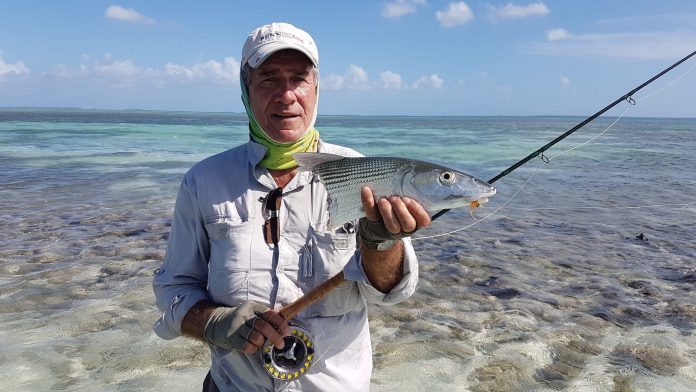by Mike Roennfedlt
I get to the Cocos Islands about once a year. It’s an expensive exercise and sometimes frustrating with plane cancellations and the like, but I’m hooked on the place. Fly fishing in shallow water isn’t everybody’s cup of tea but it is mine and I wouldn’t mind if bonefish were the one species I could catch for the rest of my life.
Having said all that, there is one issue that has been taking the gloss off the Cocos experience for some time now and it just seems to get worse every visit. I’m talking about black-tipped reef sharks, once an almost friendly presence on the Cocos sand flats but now becoming annoying and occasionally downright scary.
The process feeds on itself in some ways. The arrival of Covid and lack of overseas options has seen more people fishing there and the sharks obviously relate people standing in the water with opportunity. Hooked fish and even freshly released fish are easier targets than those swimming around normally and reef sharks aren’t backward in taking advantage. The encounter can be savagely brutal and the satisfaction of seeing a released fish swim off freely is replaced with the often unsettling reality of nature at work.
Fishing more remote spots and not spending too long in the one spot helps a bit, as does fishing in water too shallow for the bigger sharks. Regardless, the situation is evolving and not in a good way.
But on my most recent trip things went from disappointing and annoying to downright strange. Something had come over the sharks and they were travelling about in packs of a dozen or more, doing odd things.
One pack of small sharks around 60cm long were racing around the shallows near Trannies, a popular scenic spot, in a way that was reminiscent of a bunch of teenagers running amok, terrorising everything in sight.
Another group of at least 10 were surfing up the beach at North Point right on dark. One after another, like a conga line, they surfed up the beach and rode the backwash down the slope again, tails thrashing furiously.
The most unsettling though were in a group of a dozen or so that approached me on a flat out in the middle of the lagoon at low tide. As a couple of them came close I took the usual splashy step or two towards them and they scooted away momentarily before closing in again, this time with three or four others. It didn’t feel right so I started backing off toward my fishing buddy Dan. Surely the two of us acting aggressively would deter them, but that wasn’t the case. Even whacking the surface and the backs of the sharks with the fly rods had no effect so we moved into really shallow water as fast as decency would allow. Luckily, it wasn’t far to move and the sharks lost interest at that point. Needless to say, we didn’t return to that spot.
Now I’ve seen a lot of black-tipped reef sharks in my time and I doubt I’d seen one any bigger than 1.4m long, but all that changed during my previous visit to Cocos where I watched one in the shallows from the ferry jetty. This was a beauty of at least 2.1m, as thick through the body as one of Shannon Hurn’s thighs. It was accompanied by another two, each around 30cm shorter.
It didn’t happen this time but the thought of meeting any of them out on the flats would add yet another unsettling element to the Cocos sharks experience.
At various spots around the islands there are emergency aid boxes installed by the AFP (Australian Federal Police). They contain a radio and first aid kit and now I’m told, a tourniquet.
































